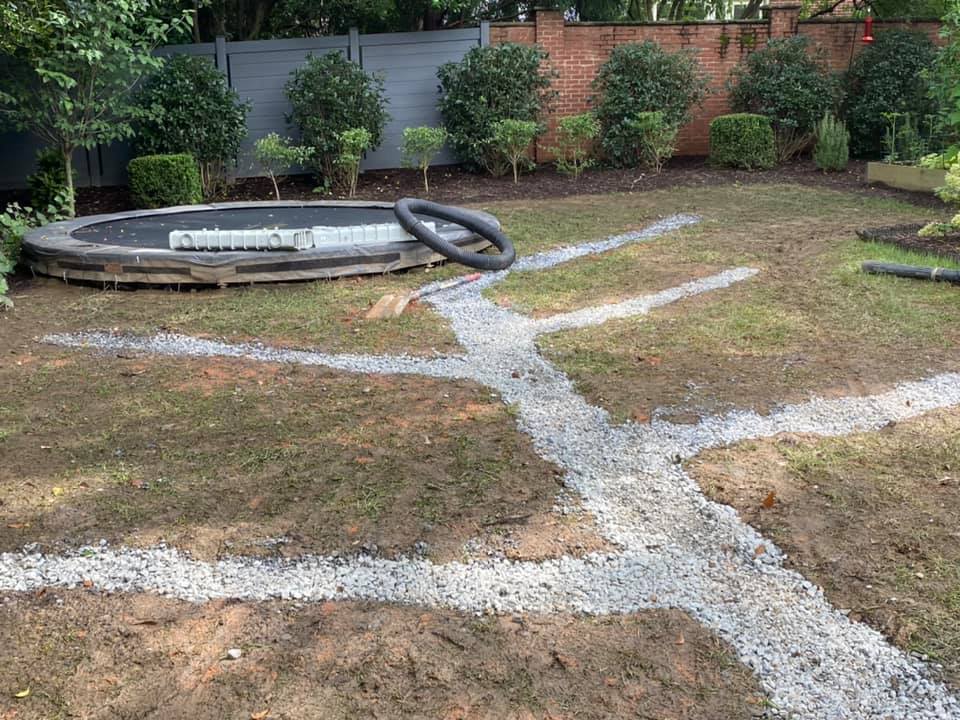French Drains are large drainage systems, dug horizontally into the soil for large scale diversion of liquids, usually water, away from your property. A French drain or weeping stone is a deep trench filled with earth or rock or consisting of a perforated route that directs surface water away from a property. Perforations through the French drains allows liquid to flow freely through the soil. Drain pipes can be laid directly into the soil, or you can dig a series of smaller steps and place them in the soil. These steps can also be perforated, and then the liquid or the sludge can flow through the drain at a higher rate than the water could on the ground.

Excavator
When installing a French drain, the French drain excavator is first brought into the scene, and then the soil is excavated for the outlet pipe by lifting up the inlet grate. This French drain system is then installed on the excavated soil. The final step is the installation of the outlet pipe into the new French drain trench. If you are installing the French drains you, then the final step would be to line the drainage hole with a steel tee, and install the Tee through the top of the French drain. Then you would repeat the whole process with the next French drain to finish.
There are many benefits associated with French drains, and the primary benefit is that French drains provide the least amount of slope to your landscape. Slope is a very important factor, especially when you are building a landscape garden. Slopes are aesthetically unappealing, they require more maintenance and cost more money to keep up. French drains actually have two degrees of slope, so you get the least amount of slope in any direction, and the least amount of maintenance required.
Steep Terrain
If you have steep terrain, French drains are the best solution because they have many different configurations. For instance, if you have a steep hillside or some other type of obstacle that you'd like to run your trench drains over, French drains are the right choice for you. You can have two footers that are dug deep enough to let your footer pass through, one outlet pipe positioned on the uphill side of the yard, and a second pipe positioned on the downhill side of the yard. The advantage of this configuration is that the French drain and outlet drain pipes are buried so deep, that water does not pool. In the event of heavy rainfall, only a portion of the soil in the trench will be affected by water accumulation, and the rest of the soil will be unaffected by the pool of water.
If you have a steep bank or hillside, and you'd like to create some type of artificial feature that mimics a tree, then you will be happy to know that there is an easy way to accomplish this. If you are going to build a landscape garden, and you are interested in plants and shrubs, then one of the best solutions for landscaping your yard with French drains. When it comes to French drains, there are three main types that are used for landscape design purposes. These types include trench drains, stone and wooden swales. Each of these types of French drains has a unique look that compliments any type of yard and landscape. For example, if you have a steep hillside, with many different types of foliage and plants, then you may want to install stone French drainage or a wooden swale.
French Drain for Basement
If you have a basement in your home, then there is another solution for adding a French drain to your landscape. A French drain can be installed inside of your foundation in order to route stormwater away from your home's foundation. This is often necessary after you install your French drains, in order to protect your basement walls from water damage. This can be extremely cost-effective, especially if you have a basement.
Fiberglass Mesh System
Stone trench drains can also be installed as well. When it comes to choosing a material for your French drains, you need to select a non-slip product that is made from cement or stone. These products are much safer than the fiberglass mesh systems that are typically used. Fiberglass mesh can be dangerous for young children and pets. Also, keep in mind that French drains do not have to be installed inside of your basement.
Screening System
If you decide to install French drains outside of your home, then a good idea would be to add a French drain screening system. There are two main types of screening systems that you can install in order to protect your French drains from soil erosion and tree roots. You will need to find a local drain cleaning and prevention company in your area, and make sure that you work with a licensed and bonded contractor. When it comes to the installation of this type of drainage system, you will need a pipe, a drain snake auger, a French drain screen, a French drain filter fabric, and a French drain valve. The total price of this type of system should not be too expensive, considering the protection that you receive.
For a more detailed exploration of this subject, visit our blog where we offer in-depth articles and expert perspectives.
What Our Customers Think
-
Paul. H
Button“There service is not only affordable but also really gets the right result.”
-
George. R
Button“They were able to quickly get on top of the problem we had.”
-
Leslie. N
Button“There’s no service you can trust more if you need a foundation problems corrected. They offer a truly professional service.”



